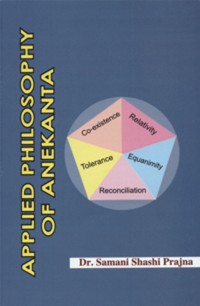He clearly said that cognitive concepts follow the law of relativity (sāpekṣvāda). Each proposition or statement is made with a certain purpose and in a certain context. So no one can claim the Reality as such either completely eternal or non eternal. Jainism denies absolute existence or absolute non- existence, absolute permanence or absolute impermanence, absolute being or absolute non-being and defends non-absolutism. An object has two fundamental aspects eternal and non-eternal. It is permanent with respect to its essential substance and impermanent with respect to the modes through which it is ceaselessly passing. The doctrine of non-absolutism finds no contradiction in a Reality, being both permanent and impermanent. To understand this, the problem of change, which has received the keen attention of all Indian thinkers is analysed. There are two fundamental and opposite views of Reality:
- only what is eternal and unchanging is real, and
- only what is incessantly changing is called real.
The former is called the philosophy of Being and the latter the philosophy of becoming. In the former change is considered as absolutely unreal, like the doctrine of an abiding entity as that of the vedānta tradition, which believes that change is only an illusion emanating from the eternal unchanging Brahman. While in the latter, it is only the modes that are real as accepted in the Buddhist philosophy. Other traditions fall somewhere in between these two extremes, such as the Sāṃkhya-yoga tradition in which, the eternal substance the soul, is absolutely constant while the primordial matter changes.
The Jaina philosophy is distinct from these theories because the eternal substance and the changing modes are viewed as real and integral. It is not that the modes alone are subject to change, while the eternal substance is also liable to change, though not to absolute cessation and disappearance like the modes. The substance is renewed as the modes of change. Change can occur in both the entity and the attribute,[1] which is very important aspect of Jain metaphysics. Transformation is defined as “the continuity of one’s own nature through change”.[2] The concept of mode is related to the concept of change. Substance and mode are the issues, which have been widely discussed in the field of philosophy under the names of Being and Becoming. According to Bhagavati Sūtra and Pannavaṇā Sūtra substance is being, permanent, identical and universal, mode is becoming, impermanent, different and particular. Bhagavati Sūtra clearly cites that reality manifests in two forms i.e. substance and mode. It doesn't mean that Reality is divided. It is, infact one but observer perceives it in two forms. Siddhasena Gaṇi supporting the scriptural view in his commentary on Tattvārtha Sūtra says, "ontologically substance and mode are inseparable. The distinction of the two is only a mental projection.[3]
 Dr. Samani Shashi Pragya
Dr. Samani Shashi Pragya

